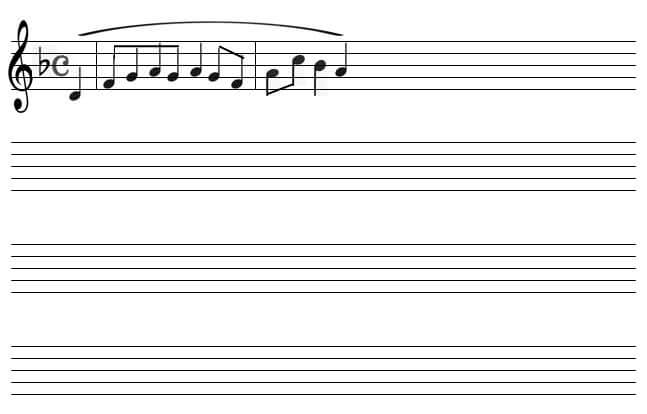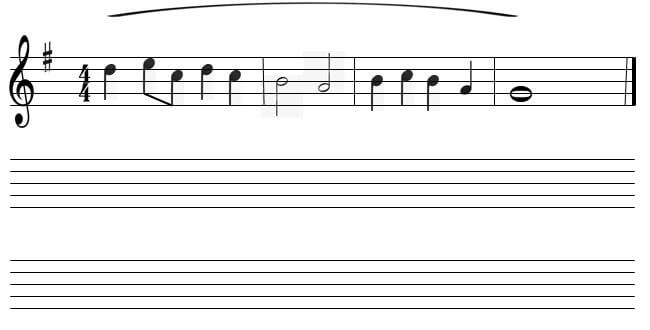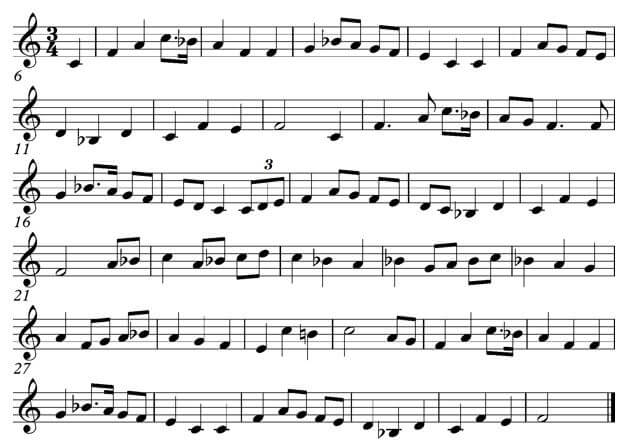Instructions to candidates
- Answer all the questions in this paper
- In question 4 choose any two parts of the questions numbered (a), (b), (c) and (d)
- All answers must be written in the spaces provided
- This paper consists of 10 printed pages
- Candidates should check the question paper to ensure that all the pages are printed as indicated and that no questions are missing
- Candidates should answer the questions in English
For Examiner’s Use Only
|
Section |
Question |
Maximum Score |
Candidate’s Score |
|
A |
1 |
15 |
|
|
2 |
15 |
||
|
B |
3 |
14 |
|
|
4 |
14 |
||
|
5 |
10 |
||
|
6 |
10 |
||
|
7 |
6 |
||
|
C |
8 |
16 |
|
|
100 |
|||

QUESTIONS
SECTION A: BASIC SKILLS (30 marks)
Answer all questions in this section
- Melody
- Starting with the given opening, compose a melody of sixteen bars for voice, modulating to the relative minor and returning to the tonic. Incorporate syncopation and appropriate tempo variation. (9 marks)

- Compose a melody and set it to the text given below. Use the treble stave and a key signature of your choice. (6mks)
Kuwatunza ni lazima
Watoto watashukuru
- Starting with the given opening, compose a melody of sixteen bars for voice, modulating to the relative minor and returning to the tonic. Incorporate syncopation and appropriate tempo variation. (9 marks)
- Harmony
Harmonize the soprano melody below for SATB. Choose appropriate chords from I, II, IV, V and VI.
SECTION B: HISTORY OF MUSIC (54 marks)
Answer all the questions in this section except in question 4 where
you should choose any two parts of the question numbered (a), (b), (c), (d).
- African Music
- Identify the communities that traditionally perform the following dances. (3 mks) Madzumbano
Ohangla
Kamabeka
Kilumi
Mwomboko
Cheptilet - Outline any four roles of music and dance during traditional African worship. (4 mks)
- State three different ways in which the solo-choral response style is used in the performance of anAfrican traditional folk song. (3 mks)
- List any four vocal techniques used to embellish a traditional folk performance. (4 mks)
- Identify the communities that traditionally perform the following dances. (3 mks) Madzumbano
- Prescribed Western Composers
Answer any two of the following questions: (a), (b), (c) and (d)- Thomas Morley
- Name his nationality. (1mk)
- State any three characteristics of the Renaissance ballet (3mks)
- What types of compositions are the following works by Morley? (3 mks)
Now is the month of maying
April is my mistress face
Sing we and chant it - State two characteristic features of Morley’s vocal music (2mark)
- Name any two contemporaries of Morley. (2mk)
- List down any three major contributions of Morley towards renaissance music.(3mks)
- Domenico Scarlatti
- Name the musical period that Giuseppe Domenico Scarlatti belong to. 1mk)
- Outline any three factors that influenced Scarlatti as a popular music composer (3mks)
- Identify any three characteristics of Scarlatti's sonatas. 3mks
- State any three contributions that Domenico made to the keyboard playing technique. (3 mks)
- Identify any two great musicians known to have trained Domenico Scarlatti. (2mks)
- Outline any two musical duties of Scarlatti in Madrid from 1729 (2mks)
- Felix Mendelssohn
- For what media was a midsummer Night’s dream op.61 by Felix Mendelssohn? (1mk)
- Why is Mendelssohn not a typical Romantic composer? (1mk)
- Explain how he treated his overture in composition. (5mks)
- Name his two composed vocal music. (2mks)
- State any three characteristics of Harmony during Romantic period music. (3mks)
- Identify any two instrumental works while in Britain (2mk
- Ralph Vaughan Williams
- What type of work is the wasp? (1 mk)
- Outline any four musical characteristics of the period in which Vaughan Williams lived. (4mks)
- Name two operas by Vaughan Williams. (2mks)
- State any three characteristics behavior of Vaughan Williams’ compositions. (3mks)
- Name any two major contributions of Vaughan Williams towards the music of England. (2mks)
- Identify any two characteristics of Vaughan’s symphonies. (2mks)
- Thomas Morley
- Analysis of Prescribed African Music
Siriri-Folk Music of East Africa- Identify any three characteristics of African folk song used in this performance. (3mks)
- Describe the musical elements of the opening section (2mks)
- State any three relationships between the voice and the first fiddle. (3mks)
- Explain the relationship in performance between the first and second fiddle (2mks)
- Analysis of Prescribed Western Music
Septet Op 20-Movement 4
(Tema Con Variazioni)- In which music period was the work composed? (1mk)
- Explain the form in the the ‘theme’ section 2mks
- Briefly explain the texture of Variation 1. 2mks
- Identify any two musical techniques used in the introduction at bars 1-4 and 4-8. 2mks
- State any three musical devices used by the viola in the whole work. (3mks)
- Analysis of Unprepared Work
- Study the music extract below and answer the questions that follow.

Describe citing the bar numbers the form In which form is the melody written? ( 3marks) - Identify two devices used to create rhythmic variety in the melody. (2 marks)
-
- State the tonality of the melody. (1 mark)
- In which key does the melody modulate before returning to the tonic and at which bar? (2marks)
-
- State the texture of this melody. (1 mark)
- Explain your answer in d(i) above. (1 mark)
- Study the music extract below and answer the questions that follow.
SECTION C: GENERAL MUSIC KNOWLEDGE (16 marks)
-
- Name any three instruments used in Sengenya dance. (3mks)
- Translate the following into staff notation. Doh is A flat (5mks)
:s,/ m:-:de/f:-re/d:-:t,/d:-// - Name any three instruments of the wood-wind section of the orchestra. (3mks)
- Transpose the following melody a minor third down in bass clef. (5mks)


MARKING SCHEME
-
-
- 16 bars 1 mark
- Modulation and back to the tonic 1 mark
- Inversion 1 mark
- Duplet 1 mark
- Phrase marks 1 mark
- Lyricism 2 marks
- Melodic contour 1 mark
-
- Speech rhythm 3 marks
- Syllabic division 1 mark
- Lyricism 1 mark
- Melodic shape 1 mark
- Rhythmic contrast 1 mark
-
-
- 14 chords 7 marks
- Cadences: (½ mark for each cadence). Total 1 mark
- Voice leading (½ marks for each voice). Total 1½ marks
- Voice range ½ mark
- Deduct 1 mark for each harmonic fault up to a maximum of 4 marks.
-
- African Music
Madzumbano – Digo dance ( ½ mk)
Ohangla - Luo (½ mk) Kamabeka - Luhya ( ½ mk)
Kilumi - Kamba ( ½ mk) Mwomboko - Kikuyu ( ½ mk) Cheptilet - Nandi ( ½ mk) Total 3mks - Identify any four roles of music and dance during traditional African worship (4mks)
- Enhances communication with God
- Establishes the appropriate mood
- Provides a medium for thanksgiving
- Reiterates theme of worship
- Encourages participants / worshippers
- Attracts new converts
1 mk each for any four correctly written roles
4mks) (Total =
- State three different ways in which the solo-choral response style is used in the performance of an African traditional folk song (3mks)
- One person (soloist) leads then respondents / group answer after soloist has finished.
- Overlapping: Respondents join in before soloist completes his or her part
- A section of the singers lead as the rest respond
- An instrument takes the lead, answered by the singers
1 mk each for any three correct responses (Total = 3mks)
- List any four vocal techniques used to embellish a traditional folk performance 4mks
- Ululation
- Whistling
- Guttural accompaniment
- Shouts 1 mk each for each correct response
- African Music
- Prescribed Western Composers
- Thomas Morley
- Nationality – English (1mk)
- State any three characteristics of the Renaissance ballet (3mks)
- a light choral piece (1mk)
- Strophic form (1mk)
- Contains a fa-la-la refrain (1mk)
1 mk for each characteristic : Total 3mks
- What type of compositions are the following works by Morley? (3mks) (Mark as follows:
- Now is the month of maying – Ballet (1mk)
- April is my mistress face – Madrigal (1mk)
- Sing we and chant it – Ballet (1mk)
1 mk for each correctly named composition Total= 3mks
- Characteristic features of Morley’s vocal music
- Lightness of touch and texture
- Vivid pictorialism
- Vitality and grace of rhythm
- Sharpness of details
- a sunny warmth of feeling
- effectiveness of declaration
- Modal in performance
- Polyphonic
- Mostly sacred
- Pithy and forcefully expressive melodies
- Almost a capella unaccompanied
Max. 2x1 mk= 02mks
- Contemporaries of Morley.
- Thomas Weelkes / John Lowland/
- William Byrd any two ( ½ x2)
1mk
- Major contributions of Morley towards renaissance music.
- Music publisher (published a Madrigal book in 1594)
- Active member of English Madrigal School
- Strong influence on the English Madrigal
- Composer of secular music
- Translated Italian Madrigals to English
- Introduced the dance like song. (Ballet) in England in 1595
Max 3x1=3mks
- Domenico Scarlatti
- Musical period that Giuseppe Domenico Scarlatti belong to.
- Baroque period 1mk
- Factors that influenced Scarlatti as a popular music composer
- Born in a music family, father Alessandro Scarlatti was a popular opera composer and keyboard virtuoso
- Movements to other countries to learn and teach music
- Different musical responsibilities and appointments.
- Influence of Portuguese and Spanish folk music.
- Influenced by Spanish guitor
- Castrato singer ''Farinelli'' assisted in singing.
3x1=3mks
- Characteristics of Scarlatti's sonatas.
- In binary form
- Modulation to remote keys
- Short and one movement
- Skill of hand crossing in playing harpsichord.
- Used fast scale passages
3x1=3mks
- Contributions that Domenico made to the keyboard playing technique.
- rapid repetition of single notes
- double note passages
- freedom of style
- modulations to remote keys
- effects obtained by crossing of hands
- free play of arpeggio notes
- one movement in binary form.
- Great musicians known to have trained Domenico Scarlatti.
- Alessandro Scarlatti (his father)
- Francesco Gasparini(his teacher)
- Gaeteno Grecco
- Handel (organ playing)
- Bernardo Pasquini 2X1=2MKS
- Musical duties of Scarlatti in Madrid from 1729
- composing opera for the private theatre
- composing harpsichord sonatas for the princess
- performing, teaching and composing music.
- Musical period that Giuseppe Domenico Scarlatti belong to.
- Thomas Morley
Felix Mendelssohn
- midsummer Night’s dream op.61 by Felix Mendelssohn was Instrumental. (1mk)
- Mendelssohn was not a typical Romantic composer since He did not expose his feelings in the music as the other Romantic composers instead he preserved the classical tradition. He was more of the classicist composer. 1mk
- How Mendelssohn treated his overture in composition.
- Exposition starts violins in high register in staccato rhythm.
- 1st melody goes to ff in energetic manner and used as bridge passage.
- Second theme is lyric, legato in strings contrasted to the first one.
- Third theme is a dance like rhythm with wide leaps.
- Next would be development section where themes are developed and even changed slightly. 5x1=5mks
- Mendelssohn’s composed vocal music.
- Operas
- Oratorios
- Hymns 2x1=2mks
- Characteristics of Harmony during Romantic period music. 3x1=3mks
- Use of chromaticism
- Quality harmony
- Harmony with dissonance
- Creat emotions and tension.
- His instrumental works while in Britain
- Overture “ The Hebrides (known as Fingal’s cave)
- The Scottish symphony –(symphony No.3)
- Conducted five of the philharmonic concert in London in 1844
- Piano octet in 1829 2x1=2mks
Ralph Vaughan Williams
- Wasps is an overture 1mk
- characteristics of Twentieth century music
- Highly diversified i.e. takes many forms
- Less tuneful
- Not usually in easy to flow
- Makes use of much dissonance
- Use of whole tone scale
- Use of 12 note technique etc 3x1=3mks
- Operas by Vaugha Williams
- High and drover
- Sir John in love
- The pilgrims progress
- The poisoned kiss
- The riders to the sea 1x2=2mks
- Characteristics behavior of Vaughan Williams’ compositions
- Had strong modal treatment
- Used antiphonal techniques in his melodies
- Most melodies and operas had strong lyricism texts.
- Use of lively cross-rhythms
- Clearly discovered how to use English folks tunes in his compositions.
- Use of harmonic dissonances
- Use of discords but consistent tonality. 1x3=3mks
- Major contributions of Vaughan Williams towards the music of England.
- Vaughan edited the English hymnal book.
- Vaughan collected the English folk tunes for use.
- Vaughan had collections of music for the oxford book of carols and songs of praise.
- Vaughan taught music in the royal college of music (RCM) in London. 1x2=2mks
- Characteristics of Vaughan’s symphonies.
- Had five movements instead of four(the choir sings in all movements)
- Enlarged and modified the finale.
- His first symphonies had programmatic elements.
- Elements of Symphony, Oratorio and Cantata in performance.
- Takes long time in performance (80 minutes)
- Had sinister echoes at the end of the scherzo
- Heterogeneous element (element of folk tune)
- Voice added to the finale of some symphonies. 1x2=2mks
Analysis of Prescribed African Music
Siriri-Folk Music of East Africa
- Characteristics of African folk song used in this performance.
- Short repetitive melodies
- Performed in strophic style(based on stanzas)
- Use of vernacular (Luhya language)
- Solo and solo response in style
- Accompaniments used with voice
- Maintain the same key.
- Majorly used on pentatonic scale. 1x3=3mks
- Elements of the opening section
- Only the two fiddles (chordophones) start
- First melody using the melodic fiddle
- Repetitive play of fiddles in question and answer style.
- Announce the authentic melody. 1x2=2mks
- Relationship between the voice and the first fiddle.
- The first fiddle(chimbengele) pitches the soloist
- The fiddle and the soloist (singer) are in unison
- The singer and fiddle create harmony
- The singer performs parallel octave lower than the first fiddle.
- The first fiddle assist the singer to maintain a given key. 1x3=3mks
- Relationship in performance between the first and second fiddle
- The high pitched fiddle play the melody in question and answer form as the low pitched fiddle adds the harmony.
- The low pitched tries to play ostinato and together with the high pitched one
- The low pitched fiddle creates some parallel sounds, an octave lower with the high pitched fiddle. 1x2=2mks
Analysis of Prescribed Western Music
Septet Op 20-Movement 4
( Tema Con Variazioni )
- Classical period 1mk
- The theme is in binary form. The first part runs from bar 1-8 and is repeated while the second one from 9-16 and is also repeated. (2mk)
- Thin polyphonic texture only three strings violin, viola and cello. (2mks)
- musical techniques used in the introduction at bars 1-4 and 4-8.
- Melody starts moderately slow (Andante)
- Violin and viola starts the melody in anacrusis style at bar 1 and clarinet and bassoon anacrusic at bar 4-5. 2mks
- Musical devices used by the viola in the whole work.
- Uses alto clef (scored in alto clef)
- Share the same melody with violin in some books 84-86. cello and viola bars 125-130.
- Play double stopping (divisi) bars12-14/63-64/73-74/123-124
- Play the turn bar 36. Play scalic bar 35.
- Play inversion bar 37. Pedaling bars 100-104/109-12 2mks
Analysis of Unprepared Work
- Ternary form AABA-The first section runs from bar 6-13. The second one from 14 to 29 and repeats the first section to the end. 3mks
-
- Use of the crothet and quaver beats interchangeably
- Use of dotted notes-dotted crotchet of quaver
- triplet at bar 17 2mks
-
- The music is composed in F major 1mk
- modulates to the Sub-dorminant-Cmajor at bar 28. 2mk
-
- Monophonic texture 1mk
- The music contains the melody line only. 1mk
SECTION C: GENERAL MUSIC KNOWLEDGE (16 marks)
- Instruments used in sengenya dance
- Mabumbumbu (Drums )
- Pastu
- Nzumari
- Leg jingle
- Chapuo
3 mks
- Staff notation 5 mks
Key signature
8 notes @ ½ mark each = 5 mks 1 mk
Total 5 mks
Wood – wind instruments of the orchestra- Trombone
- Oboe
- Tuba
- Saxophone Bassoon
- Trumplet
- French horn
- Flute Recorder
- Clarinet
- Piccolo Bugle
Any three correct answer 3 mk
- Clef
Key signature ½ mk
½ mk
8 notes ½ mark each
Total 4 mks
5 marks
Download Music Paper 3 Questions and Answers - MECS Pre Mock Exams 2023.
Tap Here to Download for 50/-
Get on WhatsApp for 50/-
Why download?
- ✔ To read offline at any time.
- ✔ To Print at your convenience
- ✔ Share Easily with Friends / Students
